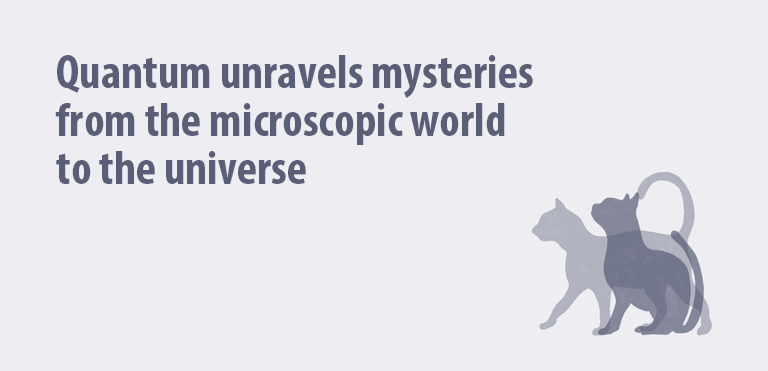
Quantum unravels mysteries from the microscopic world to the universe
Even as science rapidly progresses, the universe is full of unresolved wonders and mysteries. How can the human nose distinguish one smell from another? What do migratory birds use to fly precisely to their destination? How is a “black hole” (a celestial body from which not even light can flee) configured? Quantum science serves as the key to unraveling these mysteries. Osaka University’s Center for Quantum Information and Quantum Biology (QIQB) was officially established in March 2020. It serves as a hub for the world’s leading quantum researchers to combine their wisdom and consider which path society should take in a world where population is rapidly increasing and environmental degradation continues to progress.
Quantum defies the “laws of everyday physics”
Quantum is a unit (entity) of minute matter or energy that has the properties of both a “particle” and a “wave.” Quanta encompass atoms which form matter; electrons, neutrons and protons that make up atoms; photons which are particles of light; and elementary particles represented by neutrinos. The phenomena that people experience and intuitively understand can be explained by “classical physics.” However, the invisible microscopic world is governed by principles that differ from classical physics.
According to classical physics, “each particle exists at a certain location.” Quantum, which has the property of both a particle and a wave, loses its properties as a wave the moment its location is observed. However, in an unobserved state, it exists as a “superposition” of possible waves each corresponding to a different location.
Quantum is surprisingly “simple”
Now that the story has become somewhat complicated, let us introduce Professor Masahiro Kitagawa, Director of QIQB. Professor Kitagawa, who stands at a height of 191cm, mentions that “for some reason quantum researchers are often tall.” He looks well even though he is over 60, but when he starts talking about his research, his posture changes and he starts leaning further and further forward.
During elementary school, Professor Kitagawa was fascinated with amateur radio and he learned negative numbers, square root and even complex numbers in order to obtain an amateur radio license. During his senior high school years, he immersed himself in mathematics. The first subject he majored in at Osaka University was electronics. After researching semiconductor lasers, he became involved in developing the next-generation of optical communications at Nippon Telegraph and Telephone Public Corporation (now “NTT”). This led him to the world of quantum science.
In addition to “superposition,” quantum has another curious property. If two quanta are completely “correlated,” the state of one quantum can be known by observing the state of the other quantum, no matter how far apart they are. This property is called quantum “entanglement”, and is heavily used in quantum communications and quantum computing.
Professor Kitagawa and other researchers often say that “quantum science can be expressed by simple and beautiful mathematical equations”. The “beauty” that attracts these researchers is in fact the entrance to a complicated labyrinth.
Turning fantasy into reality
The moment we shift our perspective from the microscopic world to the visible world, it becomes difficult to reproduce phenomena according to the mathematical formulas of quantum mechanics. Light, for example, suffers attenuation as it propagates through an optical fiber, and gradually loses its special quantum properties such as entanglement. When attempting to create a quantum device, a great deal of effort and ingenuity is required to remove the effects of “noise” generated in the vicinity of the device.
Quantum computers have developed rapidly since the 2010s.They control an extremely fragile “superposition” state and the conditions for their large-scale practical use is to accurately detect and correct quantum “errors”. It has already been proven that quantum computers can outperform supercomputers in particular areas of expertise. In the future, it is expected that many phenomena based on quantum behavior will be elucidated. New discoveries in the microscopic world will improve the quality of human life in a wide range of fields, including healthcare, industry, environment, agriculture and energy.
“Teleportation” (the instantaneous transfer of matter from one point to another) is often depicted in science fiction. In the quantum world, it is possible to use entanglement to transfer “any quantum state” to a distant location at the speed of light. So as quantum research progresses, science fiction should come closer to becoming a reality.

● QIQB: Center for Quantum Information and Quantum Biology, Osaka University
QIQB was established in July 2018 as a division of the Institute for Open and Transdisciplinary Research Initiatives, Osaka University. “Quantum Information” is an interdisciplinary field between quantum physics and information and computer science, including quantum computing, quantum communications, and quantum sensing. “Quantum Biology” is an interdisciplinary field between quantum information and life science.
